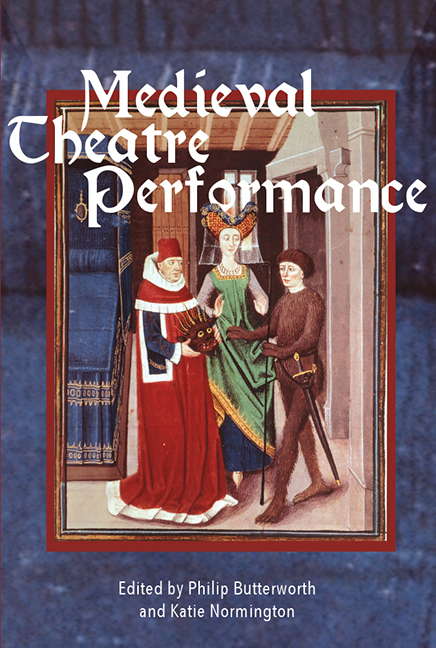Book contents
- Frontmatter
- Dedication
- Contents
- List of Illustrations
- Contributors
- Abbreviations of Principal Sources Cited
- Introduction
- Synopses
- 1 From Archive to Repertoire: The Disguising at Hertford and Performing Practices
- 2 Walk, Talk, Sit, Quit? On What Happens in Netherlandish Rhetoricians’ Plays
- 3 Performing Intrusions: Interaction and Interaxionality in Medieval English Theatre
- 4 Player Transformation: The Role of Clothing and Disguise
- 5 Pavilioned in Splendour: Performing Heaven in Fifteenth-Century Florence
- 6 Living Pictures: Drama without Text, Drama without Action
- 7 Performer-Audience Relationships in Fifteenth- and Sixteenth-century Danced Spectacles
- 8 Decadance in the Late Middle Ages: The Case of Choreomania
- 9 Writing, Telling and Showing Horsemanship in Rhetoricians’ Farce
- 10 Inanimate Performers: The Animation and Interpretive Versatility of the Palmesel
- 11 ‘lyke unto a lyvelye thyng’: The Boxley Rood of Grace and Medieval Performance
- 12 The Mechanycalle ‘Ymage off Seynt Iorge’ at St Botolph's, Billingsgate, 1474
- Bibliography
- Index
12 - The Mechanycalle ‘Ymage off Seynt Iorge’ at St Botolph's, Billingsgate, 1474
Published online by Cambridge University Press: 21 August 2018
- Frontmatter
- Dedication
- Contents
- List of Illustrations
- Contributors
- Abbreviations of Principal Sources Cited
- Introduction
- Synopses
- 1 From Archive to Repertoire: The Disguising at Hertford and Performing Practices
- 2 Walk, Talk, Sit, Quit? On What Happens in Netherlandish Rhetoricians’ Plays
- 3 Performing Intrusions: Interaction and Interaxionality in Medieval English Theatre
- 4 Player Transformation: The Role of Clothing and Disguise
- 5 Pavilioned in Splendour: Performing Heaven in Fifteenth-Century Florence
- 6 Living Pictures: Drama without Text, Drama without Action
- 7 Performer-Audience Relationships in Fifteenth- and Sixteenth-century Danced Spectacles
- 8 Decadance in the Late Middle Ages: The Case of Choreomania
- 9 Writing, Telling and Showing Horsemanship in Rhetoricians’ Farce
- 10 Inanimate Performers: The Animation and Interpretive Versatility of the Palmesel
- 11 ‘lyke unto a lyvelye thyng’: The Boxley Rood of Grace and Medieval Performance
- 12 The Mechanycalle ‘Ymage off Seynt Iorge’ at St Botolph's, Billingsgate, 1474
- Bibliography
- Index
Summary
The parish church of St Botolph, Billingsgate was one of the City churches burnt down during the Great Fire. Unlike the three other London churches dedicated to St Botolph which were rebuilt by Sir Christopher Wren—St Botolph, Aldgate; St Botolph, Bishopsgate; and St Botolph, Aldersgate—the Billingsgate church was not one of those rebuilt by Wren. John Stow considered that ‘This parish of S. Buttolph is no great thing’ because it was a place where ‘diuers strangers are there harbored’. And yet, foreign visitors may have provided the stimulus for the dedication to St Botolph, since he was sometimes regarded as the patron saint of travellers. However, Stow, writing in 1598, suggested that the church was ‘a proper Church’ which had ‘many fayre monumentes therein, now defaced and cleane gone’. John Strype, writing of the year 1559, provides an explanation for this destruction:
The 25th day [of August], at St Botolph's Billingsgate, the Rood, and the Images of Mary and John, and of the Patron of that Church, were burnt with Books of Superstition: Where at the same time a Preacher standing within the Church Wall, made a Sermon; and while he was preaching, the Books were thrown into the Fire. They then also took away a Cross of Wood that stood in the Church-yard.
During August of 1559, as a result of the Royal Visitation following on the Acts of Supremacy and Uniformity, many churches in London suffered the burning of images and roods. On 15 August, ‘the Roods in St Paul's were pulled down, and the High Altar, and other Things pertaining, spoiled’. On 24 August, ‘two great Fires made of Roods and Images of Mary and John, and other Saints’ were made in ‘Cheapside, against Ironmonger-lane, and St Thomas of Acres’ (St Thomas of Acon). Here the fires created ‘great wonder of the People’.
The church of St Botolph was home to another even more remarkable image, although it is not known if it survived up to 1559, only to be burned along with the images of Mary, John and presumably St Botolph himself.
- Type
- Chapter
- Information
- Medieval Theatre PerformanceActors, Dancers, Automata and their Audiences, pp. 215 - 238Publisher: Boydell & BrewerPrint publication year: 2017

